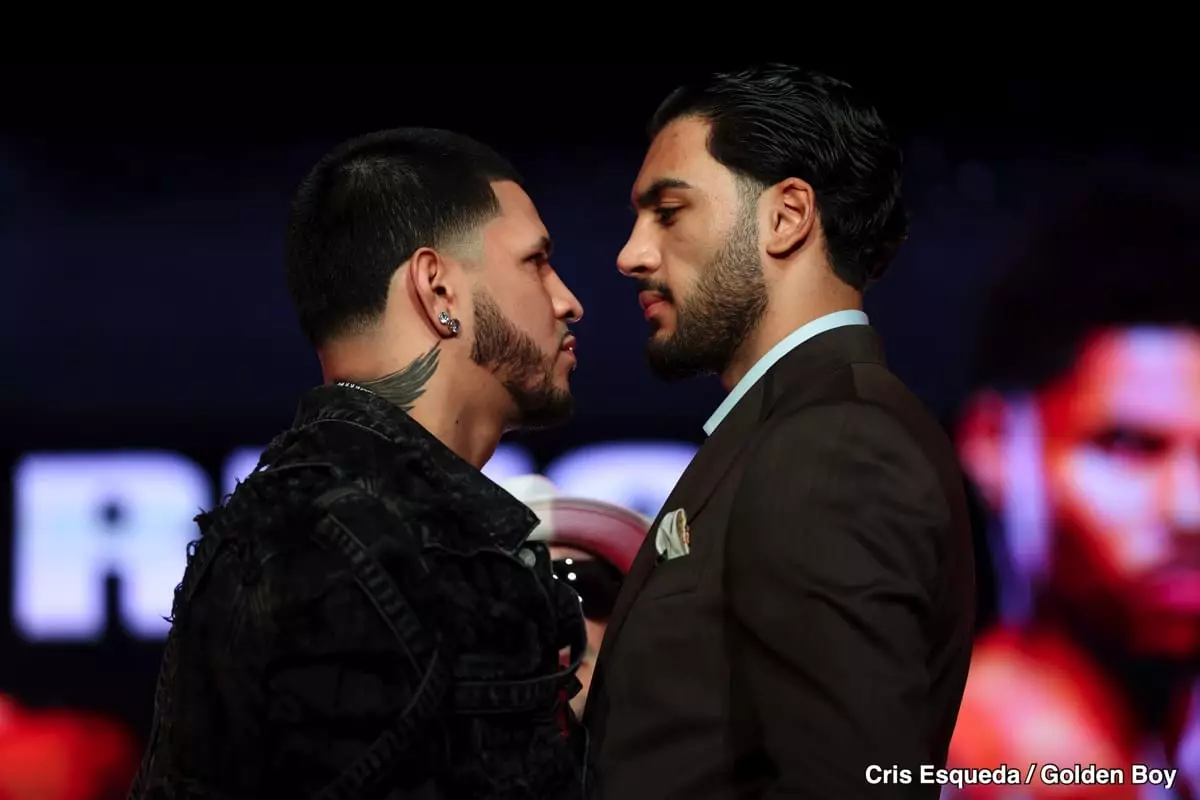In the high-stakes world of professional boxing, confidence can be as potent as fists. Edgar Berlanga, the fiery Brooklyn native, showcased this essence during the latest press conference promoting his super middleweight clash with British boxer Hamzah Sheeraz, scheduled for July 12th at the Louis Armstrong Stadium in Queens, New York. The electrical energy in the room was palpable, as Berlanga, armed with an impressive record of 23 wins—18 by knockout—demanded attention with an outspoken bravado that left little doubt as to his intentions for the fight. During the face-off, his posture and demeanor exuded dominance, leaning into Sheeraz’s personal space in a manner that could only be described as psychological warfare. Sheeraz, with a record of 21 wins, 1 draw, and 17 KOs, visibly succumbed to this intimidation, his demeanor shifting from composed to one of palpable uncertainty.
Berlanga’s approach represents a tactical understanding of boxing that extends beyond physical prowess. By instilling fear into his competitors, he not only gains a mental edge but also creates an environment where his opponent may already feel defeated before the first bell rings. This intimidation tactic has been a hallmark of many successful athletes across various sports; Berlanga is clearly channeling that age-old strategy. The mere act of leaning into Sheeraz’s space illustrated a powerful psychological maneuver, demonstrating that sometimes the battle is won long before the fight begins.
Unmasking the Roles of Promoters and Managers
While the fighters bear the brunt of the battle, the roles of promoters and managers cannot be overlooked. Turki Alalshikh, the promoter, may have underestimated Berlanga’s strengths, perhaps misjudging Sheeraz’s readiness to face such a powerful opponent. In the competitive arena of boxing, these decisions can be pivotal. Berlanga’s words cut through the noise of conventional sportsmanship as he derided Sheeraz’s management, scoffing at claims that Sheeraz was primed for victory. “That [manager] is tripping,” Berlanga asserted, showcasing a confidence that positions him squarely within the dominant narrative of the fight.
When emotions run high, and the stakes are steep, a confident fighter can be a destabilizing force. Berlanga’s criticism of Sheeraz’s past performance, particularly against WBC middleweight champion Carlos Adames, illustrates how closely the boxing community analyzes any given fighter’s trajectory. Berlanga’s comments reveal not only a dismissive attitude toward Sheeraz’s prior achievements but also serve as a reminder that boxing is as much about perception as it is about skill. Berlanga has chosen to challenge the legitimacy of Sheeraz’s abilities in a bid to assert his dominance.
Ready for the Lion’s Den
Berlanga didn’t hold back when he proclaimed his status as a “superstar” in the boxing world, insisting that he was in “the lion’s den” and that Sheeraz was merely a visitor in his domain. Such declarations do more than bolster his bravado; they resonate with the fans, who crave drama, anticipation, and the promise of visceral competition. His rhetoric transforms the fight into more than just a contest of athleticism; it morphs into a battle of egos, each fighter’s narrative intertwining in a tapestry of rivalry that the boxing world wholeheartedly embraces.
The importance of Berlanga’s words lies not only in their content but also in how their delivery enhances the spectacle of boxing. Language, particularly in sports, has a unique ability to transcend mere conversation. Berlanga’s trash talk serves to amplify the promotional aspect of the sport, drawing in audiences and boxing aficionados alike. His insistence that New York is “his” territory not only fuels local pride but also sets an elevated stage for a dramatic confrontation that promises theatricality as well as sport.
Beyond the Ring: The Cultural Impact of Boxing Rivalries
The face-off between Berlanga and Sheeraz transcends the ring, echoing the larger narratives present in boxing culture. These moments carry with them a cultural resonance that speaks to national pride, personal struggle, and the pursuit of greatness against the odds. Berlanga’s portrayal of himself as a local champion taps into a rich vein of boxing history, where athletes become larger than life figures—symbols of hope, defiance, and relentless perseverance.
In what could be seen as a microcosm of the societal battles we engage in daily, boxing’s narratives compel us to reflect on our values, our fears, and our aspirations. As Berlanga amplifies his persona, he simultaneously elevates the sport, as it is not merely about boxing; it’s a dramatic retelling of human resilience and triumph. His upcoming fight with Sheeraz embodies much more than mere athletic competition; it’s a testament to the relentless spirit that defines the human experience, making the bout not just thrilling for boxing aficionados, but a cultural spectacle worth following closely.


Leave a Reply